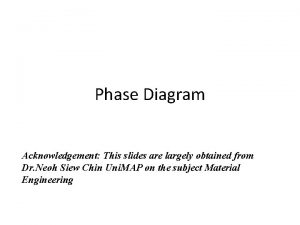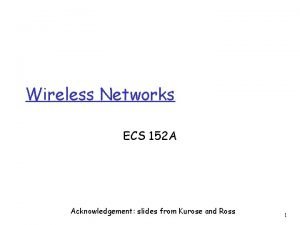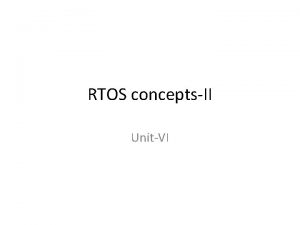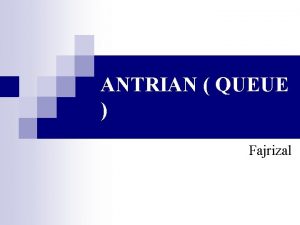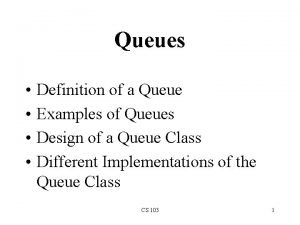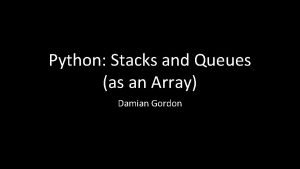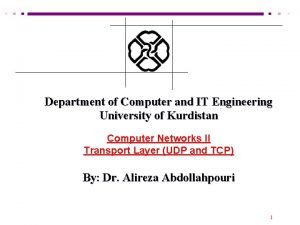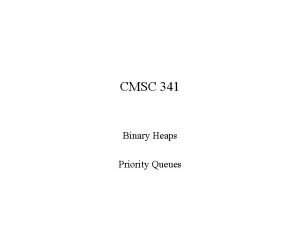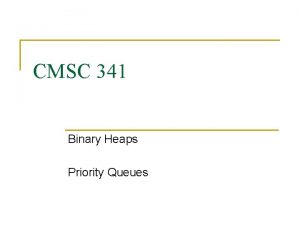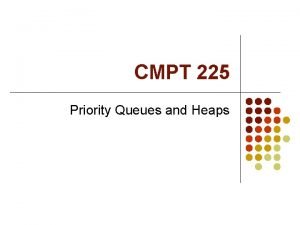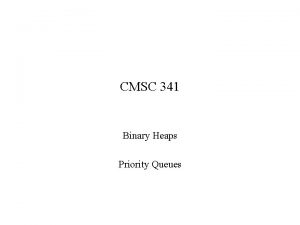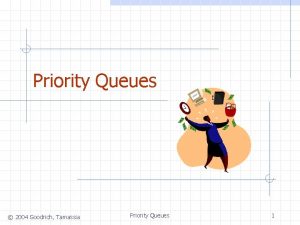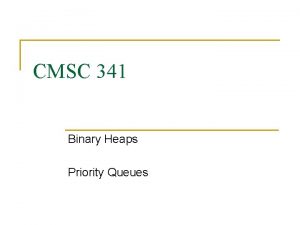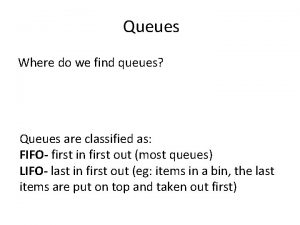CH 9 PRIORITY QUEUES ACKNOWLEDGEMENT THESE SLIDES ARE




































- Slides: 36

CH 9. PRIORITY QUEUES ACKNOWLEDGEMENT: THESE SLIDES ARE ADAPTED FROM SLIDES PROVIDED WITH DATA STRUCTURES AND ALGORITHMS IN JAVA, GOODRICH, TAMASSIA AND GOLDWASSER (WILEY 2016)

PRIORITY QUEUES • Stores a collection of elements each with an associated “key” value • • Can insert as many elements in any order Only can inspect and remove a single element – the minimum (or maximum depending) element • Applications • • • Standby Flyers Auctions Stock market

PRIORITY QUEUE ADT • • • A priority queue stores a collection of entries Each entry is a pair (key, value) • Additional methods • returns, but does not remove, an entry with smallest key, or null if the priority queue is empty Main methods of the Priority Queue ADT • insert(k, v) inserts an entry with key k and value v • remove. Min() removes and returns the entry with smallest key, or null if the priority queue is empty min() • size(), is. Empty()

TOTAL ORDER RELATION • Keys in a priority queue can be arbitrary objects on which an order is defined, e. g. , integers • Two distinct items in a priority queue can have the same key •

ENTRY ADT • An entry in a priority queue is simply a key-value pair • Priority queues store entries to allow for efficient insertion and removal based on keys • Methods: • • get. Key: returns the key for this entry get. Value: returns the value associated with this entry

COMPARATOR ADT • A comparator encapsulates the action of comparing two objects according to a given total order relation • A generic priority queue uses an auxiliary comparator, i. e. , it is external to the keys being compared • When the priority queue needs to compare two keys, it uses its comparator •


LIST-BASED PRIORITY QUEUE • • 4 5 2 3 1 1 2 3 4 5

SELECTION-SORT • 4 5 2 3 1

EXERCISE SELECTION-SORT • 4 5 2 3 1

INSERTION-SORT • 1 2 3 4 5

EXERCISE INSERTION-SORT • 1 2 3 4 5

IN-PLACE INSERTION-SORT • 5 4 2 3 1 4 5 2 3 1 2 4 5 3 1 2 3 4 5

2 5 9 HEAPS 6 7

WHAT IS A HEAP? • 2 5 9 6 7 last node

HEIGHT OF A HEAP • depth keys 0 1 1 2 1

EXERCISE HEAPS •

INSERTION INTO A HEAP 2 5 • 9 6 z 7 insertion node 2 5 9 6 7 z 1

UPHEAP • 2 1 5 9 1 7 z 6 5 9 2 7 z 6

REMOVAL FROM A HEAP 2 5 • 9 7 6 w last node 7 5 9 w 6

DOWNHEAP • 5 7 5 9 w 7 6 9 w 6

UPDATING THE LAST NODE • The insertion node can be found by traversing a path of O(log n) nodes • Go up until a left child or the root is reached • If a left child is reached, go to the right child • Go down left until a leaf is reached • Similar algorithm for updating the last node after a removal

HEAP-SORT • •

EXERCISE HEAP-SORT •

ARRAY-BASED HEAP IMPLEMENTATION 2 • 5 6 9 7 2 5 6 9 7 0 1 2 3 4

PRIORITY QUEUE SUMMARY insert(e) Ordered List (Insertion Sort) Unordered List (Selection Sort) Binary Heap, Vector-based Heap (Heap Sort) remove. Min() PQ-Sort total

MERGING TWO HEAPS 3 8 2 5 4 6 • 7 3 8 2 5 4 6 2 3 8 4 5 7 6

BOTTOM-UP HEAP CONSTRUCTION • 2 i -1 2 i+1 -1

EXAMPLE 16 15 4 25 16 12 6 5 15 4 7 23 11 12 6 20 27 7 23 20

EXAMPLE 25 16 5 15 4 15 16 11 12 6 4 25 5 27 9 23 6 12 11 20 23 9 27 20

EXAMPLE 7 8 15 16 4 25 5 6 12 11 23 9 4 5 25 20 6 15 16 27 7 8 12 11 23 9 27 20

EXAMPLE 10 4 6 15 16 5 25 7 8 12 11 23 9 27 20 4 5 6 15 16 7 25 10 8 12 11 23 9 27 20

ANALYSIS •

ADAPTABLE PRIORITY QUEUES •

LOCATION-AWARE ENTRY • Locators decouple positions and a entries in order to support efficient adaptable priority queue implementations (i. e. , in a heap) • Each position has an associated locator • Each locator stores a pointer to its position and memory for the entry g e

POSITIONS VS. LOCATORS • Position • • • represents a “place” in a data structure related to other positions in the data structure (e. g. , previous/next or parent/child) often implemented as a pointer to a node or the index of an array cell Position-based ADTs (e. g. , sequence and tree) are fundamental data storage schemes • Locator • • identifies and tracks a (key, element) item • often implemented as an object storing the item and its position in the underlying structure unrelated to other locators in the data structure Key-based ADTs (e. g. , priority queue) can be augmented with locator-based methods
 Adaptable priority queues
Adaptable priority queues Applications of priority queues
Applications of priority queues 3 min quiz
3 min quiz Mikael ferm
Mikael ferm Burman's priority list gives priority to
Burman's priority list gives priority to Priority mail vs priority mail express
Priority mail vs priority mail express Acknowledgement slides
Acknowledgement slides Templates
Templates Acknowledgement slides
Acknowledgement slides Acknowledgement slide
Acknowledgement slide Acknowledgement for ppt project
Acknowledgement for ppt project Acknowledgement slides
Acknowledgement slides Kindratenko
Kindratenko How to present acknowledgement slide
How to present acknowledgement slide Acknowledgement slides
Acknowledgement slides Martinos email
Martinos email Java stacks and queues
Java stacks and queues Pipes in rtos
Pipes in rtos Java stacks and queues
Java stacks and queues Queue representation
Queue representation Struktur data queue sering digunakan untuk
Struktur data queue sering digunakan untuk Java stack exercises
Java stack exercises Definition of queu
Definition of queu Empty python
Empty python Message queue in unix
Message queue in unix A small child slides down the four frictionless slides
A small child slides down the four frictionless slides Change in energy quick check
Change in energy quick check These slides
These slides These slides
These slides Following slides
Following slides B.tech final year project report sample
B.tech final year project report sample Bayside council acknowledgement of country
Bayside council acknowledgement of country D-sack sequence
D-sack sequence The value of acknowledgement field in a segment defines
The value of acknowledgement field in a segment defines Expectational acknowledgement
Expectational acknowledgement Acknowledgement in presentation
Acknowledgement in presentation Acknowledgement in presentation
Acknowledgement in presentation








